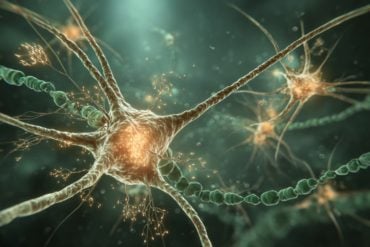Summary: Researchers have optimized optical and electrophysiological recordings from single neurons to study axonal excitability with unprecedented detail.
Source: Max Planck Florida Institute for Neuroscience.
Researchers at the Max Planck Florida Institute for Neuroscience uncover important organizational features of axonal excitability in a near synapse-by-synapse manner.
Advancing the understanding of integrative features of the nervous system
There are three main functions of the nervous system: sensory function, which detects changes in the body; integrative function, which makes decisions based on information it receives; and motor function, which carries electrical impulses to stimulate a response. In particular, the integrative functions of the brain bring sensory information together, add to memory, produce thoughts, and make decision.
The cerebellum, part of the brain that is responsible for motor control, serves as an optimal model system to study the integrative features of the nervous system at both the cellular and network level. The circuitry of the cerebellum is strikingly simple when compared with other regions of the brain, with a regularly repeating cellular organization across its outer layer. In addition, cerebellar-dependent tasks have been well-mapped to particular anatomical sub regions. Therefore, the cerebellum offers a unique opportunity to study the dynamics of how information is transferred and transformed within and between neurons to control motor behavior.
Neurons are divided in three main parts: dendrites, axons, and the soma. While dendrites receive and integrate synaptic input, axons transmit the resultant, compiled synaptic information to specific sites in the form of action potentials. Even within these structures there is sub-specialization; dendrites often support functional domains, or dendritic spines, multiplying their computational capacity. And axons achieve a high-degree of specificity in the organization and functional influence of sodium and potassium channels, despite the simplistic classical view of action potentials as monotypic binary pulses transmitted throughout the entire extent of an axon.
In their June 2016 publication in Neuron, researchers Matthew J.M. Rowan, Ph.D., and Jason M. Christie, Ph.D., describe how they overcame a major technical challenge precluding direct examination of axonal excitability. Because of its small diameter – less than 500 nanometers – the typical axon can’t be examined by the conventional electrophysiological recordings. However, using optically-guided subcellular patching, in combination with organic actuators of neural activity, the scientists were able to sample targeted sub regions of axonal membrane including both presynaptic boutons and their attached axon shafts. This recording configuration allows for the direct assessment of the distribution and biophysical properties of ion channels and receptors expressed along an axon. And, in conjunction, it allows for the direct recording of neural signals including action potentials and subthreshold synaptic activity.

Notably, this study demonstrated that action potentials, often viewed as invariant pulses, are instead quite dynamic with their shape varying with subcellular location. The varicose geometry of boutons, alone, does not impose striking differences in spike duration. Rather, this physiology depends on the differential influence of potassium channel subtypes as well as a clustering of fast-activating potassium channels at presynaptic locations. The organizational feature described by this study allows axons to multiply their adaptive properties by tuning excitation in one axonal domain independent of other domains on an exquisitely local spatial scale, including between neighboring sites of release.
Future directions
According to Dr. Rowan, the clustered arrangement and variable expression density of potassium channels at boutons are key determinants underlying compartmentalized control of action potential width in a near synapse-by-synapse manner. Such organization yields a powerful adaptive property allowing individual release sites to locally inform the duration of a propagating spike, dependent on the local abundance of channels, and separate of other sites. Dr. Christie’s research team will further investigate how spike signaling within axons is organized and modified, and the computational value of this organization to cerebellar microcircuits.
Source: Max Planck Florida Institute for Neuroscience
Image Source: This NeuroscienceNews.com image is credited to Max Planck Florida.
Original Research: Abstract for “Synapse-level determination of action potential duration by K+ channels in axons” by Matthew J.M. Rowan, Gina DelCanto, Jianqing J. Yu, Naomi Kamasawa, and Jason M. Christie in Neuron. Published online June 23 2016 doi:10.1016/j.neuron.2016.05.035
[cbtabs][cbtab title=”MLA”]Max Planck Florida Institute for Neuroscience. “The Finer Details of Neuronal Communication.” NeuroscienceNews. NeuroscienceNews, 23 June 2016.
<https://neurosciencenews.com/synapse-neural-communication-4555/>.[/cbtab][cbtab title=”APA”]Max Planck Florida Institute for Neuroscience. (2016, June 23). The Finer Details of Neuronal Communication. NeuroscienceNew. Retrieved June 23, 2016 from https://neurosciencenews.com/synapse-neural-communication-4555/[/cbtab][cbtab title=”Chicago”]Max Planck Florida Institute for Neuroscience. “The Finer Details of Neuronal Communication.” https://neurosciencenews.com/synapse-neural-communication-4555/ (accessed June 23, 2016).[/cbtab][/cbtabs]
Abstract
Synapse-level determination of action potential duration by K+ channels in axons
Highlights
•Spike duration varies between presynaptic boutons within an individual SC axon
•The varicose geometry of presynaptic boutons does not alter spike duration
•Fast-activating K+ channels are clustered at boutons and restricted from shafts
•AP duration is determined by Kv3 channels immediately local to an individual bouton
Summary
In axons, an action potential (AP) is thought to be broadcast as an unwavering binary pulse over its arbor, driving neurotransmission uniformly at release sites. Yet by recording from axons of cerebellar stellate cell (SC) interneurons, we show that AP width varies between presynaptic bouton sites, even within the same axon branch. The varicose geometry of SC boutons alone does not impose differences in spike duration. Rather, axonal patching revealed heterogeneous peak conductance densities of currents mediated mainly by fast-activating Kv3-type potassium channels, with clustered hotspots at boutons and restricted expression at adjoining shafts. Blockade of Kv channels at individual boutons indicates that currents immediately local to a release site direct spike repolarization at that location. Thus, the clustered arrangement and variable expression density of Kv3 channels at boutons are key determinants underlying compartmentalized control of AP width in a near synapse-by-synapse manner, multiplying the signaling capacity of these structures.
“Synapse-level determination of action potential duration by K+ channels in axons” by Matthew J.M. Rowan, Gina DelCanto, Jianqing J. Yu, Naomi Kamasawa, and Jason M. Christie in Neuron. Published online June 23 2016 doi:10.1016/j.neuron.2016.05.035






